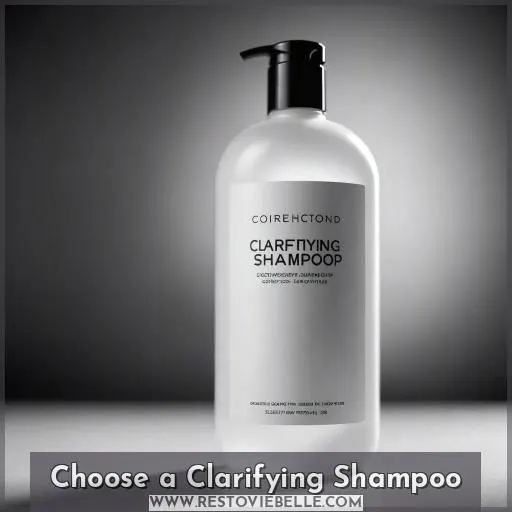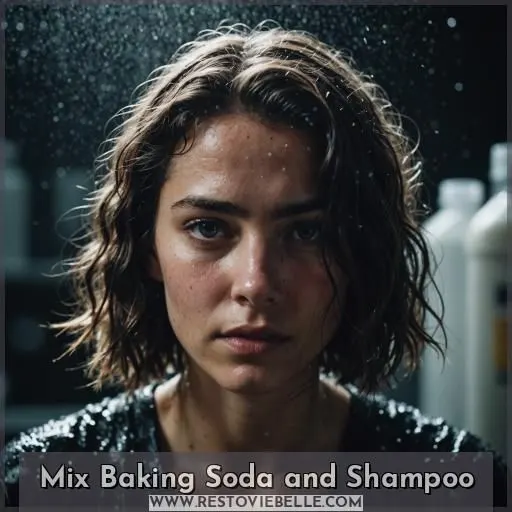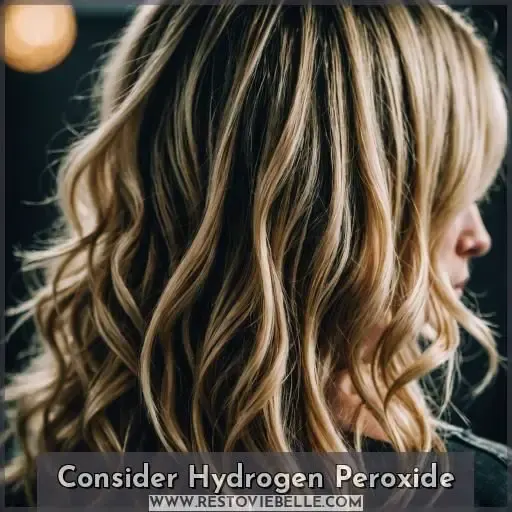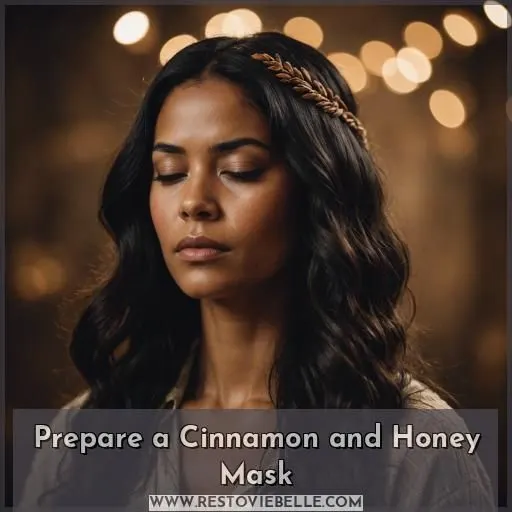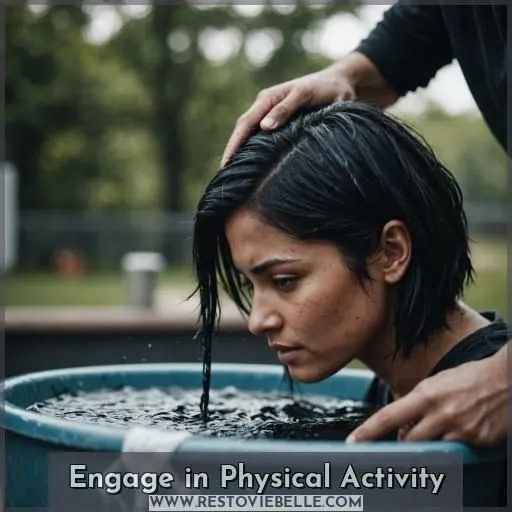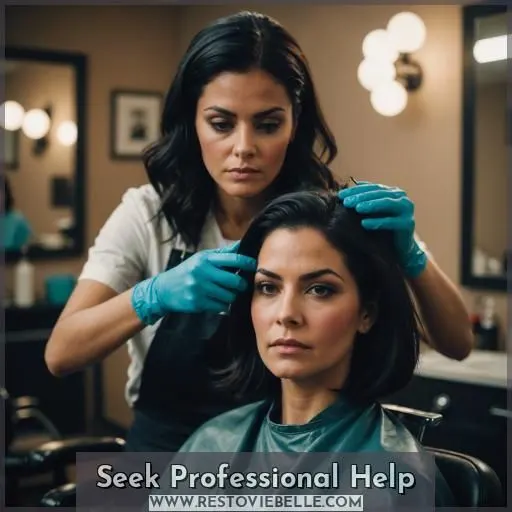This site is supported by our readers. We may earn a commission, at no cost to you, if you purchase through links.
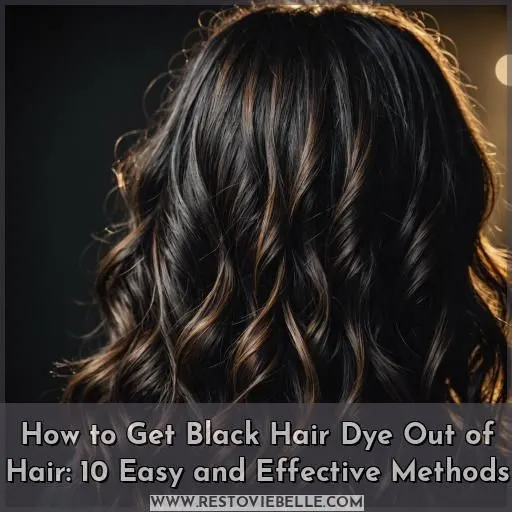 To get black hair dye out of your hair, start by choosing a clarifying shampoo specifically designed for color removal. Be cautious with mild clarifying shampoos to prevent excessive drying. Alternatively, you can mix baking soda with your shampoo for a gentle hair dye remover.
To get black hair dye out of your hair, start by choosing a clarifying shampoo specifically designed for color removal. Be cautious with mild clarifying shampoos to prevent excessive drying. Alternatively, you can mix baking soda with your shampoo for a gentle hair dye remover.
A vinegar rinse can also help neutralize dyes and remove impurities. If you prefer a natural method, dilute lemon juice with water and apply it to your hair, focusing on the areas to be lightened.
For professional assistance, consider hair stripping with sulfur-based products or using Malibu CPR to release unwanted pigment without affecting your natural color. Remember to follow up with a conditioner to replenish moisture.
Table Of Contents
- Key Takeaways
- How to Get Black Hair Dye Out of Hair?
- Choose a Clarifying Shampoo
- Mix Baking Soda and Shampoo
- Try a Vinegar Rinse
- Apply Lemon Juice
- Consider Hydrogen Peroxide
- Use Vitamin C Tablets
- Apply Olive Oil
- Prepare a Cinnamon and Honey Mask
- Engage in Physical Activity
- Seek Professional Help
- Frequently Asked Questions (FAQs)
- Conclusion
Key Takeaways
- Choose a clarifying shampoo specifically designed for color removal, but use it cautiously to prevent excessive drying.
- Mix baking soda with shampoo for a gentle hair dye remover.
- A vinegar rinse can help neutralize dyes and remove impurities.
- For professional assistance, consider hair stripping with sulfur-based products or using Malibu CPR to release unwanted pigment without affecting your natural color.
How to Get Black Hair Dye Out of Hair?
To remove black hair dye from your hair, you can try various methods. One effective method is using a color remover, which opens the hair cuticle and breaks down the color molecules without damaging your natural hair or lightening your natural color. Another option is using a baking soda paste, which is abrasive and can help rub out color molecules, especially for demi- and semi-permanent hair dyes. You can also mix vitamin C powder with your shampoo, which is an acidic compound that can dissolve color molecules in your hair. If these methods don’t work, you can consider visiting a salon for a professional service, as black dye is known to be difficult to remove. Remember to be patient and take your time with these processes to avoid damaging your hair.
Choose a Clarifying Shampoo
You’ll want to start with a clarifying shampoo designed to remove hair color and product buildup. While effective, use clarifying shampoos cautiously as they can be drying and may strip too much color – a professional colorist can provide guidance if you’re unsure.
Clarifying Shampoo for Color Removal
To remove black hair dye using a clarifying shampoo, follow these steps:
- Choose a clarifying shampoo that isn’t color-safe, as these shampoos are specifically designed to remove product buildup, excess oil, dirt, and impurities from the hair and scalp.
- Avoid using shampoos that explicitly state they’re safe for color-treated hair, as these may not effectively remove hair dye.
- Read reviews from other users to see if a particular clarifying shampoo has helped others remove hair dye.
- Use a mild clarifying shampoo, as these are helpful for stripping away product buildup and impurities from the strands or excess sebum.
- Follow up with a conditioner to help replenish moisture and protect the hair from further damage.
Precautions with Clarifying Shampoo
When using a clarifying shampoo to remove color from your hair, it’s imperative to take some measures to guarantee the best results and minimize possible damage. Here are some tips to follow:
- Choose a Clarifying Shampoo for Color Removal: Look for a clarifying shampoo specifically designed for color-treated hair. These shampoos are gentle on your hair and won’t remove the color too quickly. Avoid shampoos that explicitly state they’re safe for color-treated hair, as they may not be as effective for color removal.
- Follow Directions: Always read and follow the instructions on the shampoo packaging. This will help you avoid stripping your hair too much, which can lead to damage and dryness.
- Avoid Excessive Use: Clarifying shampoos can be drying to your hair and scalp. Use them no more than once a week or once a month, depending on your hair’s needs.
- Massage Gently: When applying the shampoo, massage it gently into your scalp to remove product buildup and impurities. Be careful not to scrub too hard, as this can damage your hair and scalp.
- Rinse Thoroughly: After leaving the shampoo in for the recommended time, rinse it out thoroughly to avoid any residue that could potentially damage your hair.
- Condition Afterward: Use a conditioner to help replenish moisture and protect your hair from further damage. This step is especially important if you have color-treated hair, as it can be more prone to dryness.
- Consider Professional Assistance: If you’re unsure about using a clarifying shampoo or if you’ve tried it and haven’t seen the desired results, consider seeking professional help. A colorist or stylist can provide specialized treatments and products to help remove unwanted color from your hair.
Professional Assistance for Color Stripping
If you seek to eliminate black hair dye from your hair, it’s essential to consider seeking professional guidance.
Hair stripping, involving the use of sulfur-based products, can be a complex procedure that requires expertise to avoid hair damage.
Malibu CPR is a popular technique for removing unwanted pigment without compromising natural color, but it’s crucial to adhere to the prescribed treatment duration and use the appropriate products.
Kenra Professional clarifying shampoo can help remove product buildup prior to the CPR treatment.
The Kenra Professional Blue Powder Lightener with 30 volume developer can be used to brighten hair after the CPR treatment.
Mix Baking Soda and Shampoo
Mixing baking soda with your shampoo is a gentle and effective method for removing black hair dye. Baking soda is known for its ability to neutralize dyes and remove impurities from hair. By adding a small amount of baking soda to your shampoo, you can create a powerful cleaning solution that targets the unwanted pigment in your hair.
To use this method, simply mix a tablespoon of baking soda with your shampoo in your palm before applying it to your hair. Gently massage the mixture into your scalp and hair, focusing on the areas where the black dye is most visible. Rinse thoroughly with warm water, and repeat the process if necessary.
This method is particularly useful for those with sensitive scalps, as baking soda is a natural exfoliant that can help remove dandruff and other impurities without causing irritation. Additionally, it’s a cost-effective and easily accessible option for those looking to remove black hair dye without the need for professional assistance or specialized products.
Remember to be patient with this method, as it may take several applications to fully remove the black dye. Always follow up with a deep conditioning treatment or hair mask to help restore moisture and prevent damage to your hair.
Try a Vinegar Rinse
Vinegar rinse is a well-liked home remedy for removing hair dye, especially for those seeking to lighten their hair or remove undesirable color. It’s a natural lightener that can help to fade hair dye without causing significant damage to your hair. The acidic nature of vinegar can help to break down the dye molecules, making it easier to rinse out.
To use a vinegar rinse, you can mix equal parts vinegar and warm water. White vinegar is often recommended for this purpose, as it’s more acidic than apple cider vinegar. Apply the mixture to your hair, ensuring it’s well saturated. Then, cover your hair with a shower cap or plastic bag and let it soak for 15 to 20 minutes. Afterward, shampoo your hair and rinse it thoroughly. You may need to repeat the process several times to fully remove the dye.
It is essential to note that vinegar rinse may not completely remove permanent hair color. However, it can help to lighten or fade the color, making it a suitable option for those with semi-permanent or demi-permanent dyes. Also, be cautious when using vinegar rinse on red hair dye, as it may cause the color to fade or change.
If you have sensitive scalp or are allergic to vinegar, you may want to explore alternative methods for removing hair dye, such as using a clarifying shampoo or a baking soda paste. Always remember to follow the instructions carefully and consult a professional if you’re unsure about any hair dye removal method.
Apply Lemon Juice
Lemon juice is a natural and effective way to lighten your hair, thanks to its acidity and the presence of citric acid, which can whiten and lighten hair. To apply lemon juice to your hair, you can dilute it with water to create a mixture that’s safe for your hair and scalp. Be sure to apply the mixture evenly to your hair, focusing on the areas you want to lighten, and leave it on for about 1-2 hours in the sun to activate the lightening process. Afterward, rinse your hair thoroughly and deep condition to restore shine and moisture.
It’s essential to use caution when applying lemon juice to your hair, as it can be drying and may cause irritation or damage if used excessively. To minimize the risk of damage, consider using a clarifying shampoo before applying lemon juice to remove any buildup or residue from your hair. Additionally, be sure to wear sunscreen on any exposed skin while your hair is being treated with lemon juice, as the sun can intensify the lightening effects.
Lemon juice can also provide other benefits to your hair, such as improving the pH balance on your scalp, reducing irritation like itchiness, dryness, and flaking, and helping to treat seborrheic dermatitis. However, it’s important to use lemon juice in moderation and not overuse it, as excessive use can lead to dryness and breakage.
Consider Hydrogen Peroxide
You should exercise caution when considering hydrogen peroxide for removing black hair dye. While it’s a potent lightening agent, it needs to be properly diluted to avoid damage; start with a low concentration and gradually increase as needed. Hydrogen peroxide can effectively strip color, but overuse can lead to dryness, breakage, and an uneven, brassy tone.
Hydrogen Peroxide Cautions
Hydrogen peroxide is a potent bleaching agent that can be used to remove hair dye, but it comes with certain caveats. When using hydrogen peroxide for hair dye removal, it’s imperative to dilute it aptly to avoid compromising the integrity of your hair or provoking scalp irritation. A 30% hydrogen peroxide solution, for instance, should be diluted to a 10% solution by adding distilled water. Invariably add the peroxide to the water and not vice versa to preclude a boisterous reaction**.
While hydrogen peroxide can be efficacious in removing hair dye, it can also inflict damage to the hair, encompassing dryness, fragility, and hair loss. It can also lead to disparate color distribution, resulting in color patches of lighter and darker hair. Hence, it’s paramount to use hydrogen peroxide with caution and adhere to proper dilution guidelines to mitigate the risk of damage.
Dilution for Safe Use
Diluting hydrogen peroxide is critical for safe use. A 1:1 ratio is generally suggested, and it’s vital to perform a patch test before applying it to your entire head to check for allergic reactions or extreme dryness. Excessive use can lead to hair damage, so use this method infrequently to prevent dryness and brittleness.
Potent Lightening Effects
When contemplating potent lightening effects, hydrogen peroxide can be an effective tool. However, it’s imperative to dilute it appropriately and exercise prudence. Hydrogen peroxide bleach powder can be blended with toner application for a more controlled lightening process.
Bear in mind that hair porosity plays a significant role in how rapidly the dye dissipates. Damage mitigation and heat protection are essential to preserve hair health during the removal process.
Use Vitamin C Tablets
To remove black hair dye with vitamin C tablets, follow these steps:
- Crush 10-30 tablets in a resealable plastic bag using a rolling pin.
- Mix the crushed tablets with 3 to 4 tablespoons of shampoo in a bowl.
- Apply the mixture to your hair, making sure it’s damp but not dripping wet.
- Massage the paste into your hair from root to tip, making sure it’s fully covered.
- Let the paste sit for 20-30 minutes, then rinse it out with warm water.
- Shampoo and condition your hair as usual.
Vitamin C tablets can be effective in lightening hair, but they may not completely remove the dye. For best results, consider using a clarifying shampoo before applying the vitamin C paste to remove any buildup or impurities that may interfere with the dye removal process.
When using vitamin C tablets to remove hair dye, be aware of your hair type and the potential for irritation. If you have sensitive skin, you may need to dilute the vitamin C solution or use a gentler form of vitamin C, such as tetrahexyldecyl ascorbate (THDA), which is oil-soluble and less likely to cause irritation.
To ensure the safety and effectiveness of this method, consult with a professional hair stylist or colorist before attempting to remove black hair dye with vitamin C tablets. They can provide personalized advice based on your hair type and color, as well as recommend additional products or techniques to enhance the dye removal process.
Apply Olive Oil
Apply Olive Oil for Black Hair Dye Removal
Olive oil is a popular component in hair care, renowned for its nurturing qualities. It can be useful for removing black hair dye due to its ability to moisturize dry hair, fortify hair follicles, and mend damage. Here’s how to utilize olive oil for black hair dye removal:
- Choose the Right Olive Oil: Extra virgin olive oil is the finest quality and least altered, making it an exceptional choice for hair care.
- Apply Olive Oil to Hair: Gently massage the oil into your scalp and hair, focusing on areas with the most dye accumulation.
- Leave It On: Allow the olive oil to sit on your hair for at least 30 minutes to 2 hours, depending on your hair type and the degree of conditioning you require.
- Rinse and Shampoo: After the treatment, rinse your hair thoroughly with warm water and shampoo as customary.
Olive oil can also be used in conjunction with other ingredients, such as tea tree oil, for a more potent hair mask. It’s critical to note that olive oil may leave your hair oily, especially if your hair is fine or oily, but this effect is typically temporary and can be eliminated by washing and conditioning your hair.
Using olive oil for black hair dye removal can help reduce damage and breakage, enhance shine, and soften your hair. It’s a gentle and natural alternative to harsh chemicals frequently used in hair dye removal products.
Prepare a Cinnamon and Honey Mask
Prepare a Cinnamon and Honey Mask for Black Hair Dye Removal
If you’re looking for a natural and effective way to remove black hair dye, consider trying a cinnamon and honey mask. This DIY hair treatment combines the benefits of cinnamon and honey to promote hair growth, prevent hair fall, and regulate hair growth cycles. Here’s how to make and apply the mask:
- Gather your ingredients:
- 2 tablespoons of natural honey
- 1 teaspoon of cinnamon powder
- 1 egg (optional)
- 1 tablespoon of coconut oil (optional)
- Mix the ingredients:
- In a small bowl, combine 2 tablespoons of natural honey and 1 teaspoon of cinnamon powder.
- If desired, add 1 egg and 1 tablespoon of coconut oil to the mixture.
- Mix the ingredients well to create a smooth paste.
- Apply the mask:
- Begin by brushing your scalp and hair to remove any dirt or debris.
- Apply the cinnamon and honey mask to your scalp and hair, focusing on the areas with the most black hair dye.
- Massage the mask gently into your scalp and hair, using your fingers or a brush.
- Cover your hair with a shower cap or plastic wrap to keep the mask in place.
- Wait and rinse:
- Leave the mask on for 15-30 minutes, depending on your hair type and desired results.
- Rinse your hair thoroughly with warm water, followed by a gentle shampoo to remove any residue.
- Repeat as needed:
- For best results, apply the cinnamon and honey mask once or twice a week until you achieve your desired level of black hair dye removal.
Engage in Physical Activity
Engaging in physical activity can be beneficial for your overall well-being, but it can also affect your hair, especially if you have dyed hair. Sweat can damage your hair by stripping it of its natural oils, leading to dryness, breakage, and loss of luster. Here are three ways to protect your hair from sweat damage:
- Wear a cotton headband: During exercise, use a cotton headband to absorb sweat and prevent it from trickling down your hair, which can lead to breakage.
- Replace elastics with gentle methods: If you tie your hair up, switch to more gentle methods like clips or fabric-covered hair ties to protect your hair from breakage.
- Wash your hair after exercising: After exercising, wash your hair to get rid of sweat before it can cause any potential damage. Use a gentle shampoo and follow up with a conditioner to help replace lost moisture.
Seek Professional Help
Regarding the removal of black hair dye, it can pose a significant challenge, particularly for lightening the hair. However, with the appropriate techniques and professional guidance, you can attain the desired outcome without compromising your hair’s health or its natural shade.
One of the most effective methods for removing black hair dye is to seek professional assistance. Salon professionals possess access to specialized products and processes that can safely and efficiently eliminate unwanted pigment from your hair. For instance, Malibu CPR is a widely used treatment that releases unwanted pigment from oxidized hair color without impacting the natural hair pigment, preserving hair integrity, and removing mineral and other buildup.
Professional color correction services can also assist in blending and breaking up previously dyed hair, ensuring a seamless transition to your desired look. These services often involve a consultation appointment, allowing the colorist to evaluate your hair’s current state and determine the most suitable approach for your specific needs.
Additionally, salon treatments such as color stripping and bleaching may be required for more stubborn cases. While these methods can be effective, they may necessitate multiple sessions to achieve the desired outcome.
When contemplating professional hair dye removal, it’s crucial to prioritize the health and integrity of your hair. Safe removal methods prioritize your hair’s health, mitigating the risk of damage that can result from harsh chemicals or abrasive techniques.
Frequently Asked Questions (FAQs)
How often should I wash my hair during the removal process?
You should wash your hair every 2-3 days during the removal process. This frequency allows for the gradual fading of the black hair dye while minimizing damage to your hair.
Can I use heat styling tools during the removal process?
You can use heat styling tools during the removal process, but it’s recommended to apply a heat protectant first to minimize damage. Additionally, try to let your hair air dry as much as possible and use no-heat techniques for curls or waves.
What are the best color-safe shampoos for black hair dye?
For black hair dye, opt for Kérastase’s Chroma Absolu Bain Respect Shampoo or Good Housekeeping’s top pick, Keratin Smooth Color Shampoo, to maintain color while giving your locks the royal treatment they deserve.
How can I protect my hair from the sun during the removal process?
To protect your hair from the sun during the removal process, cover it with a hat, scarf, or bandana. This helps prevent color fading and keeps your hair healthy.
How long does it take for black hair dye to fade completely?
Black hair dye can take up to a year to fade completely, depending on the length of time you’ve been dyeing your hair black and the methods you use to remove it.
Conclusion
If you’ve accidentally stained your hair with black hair dye and want to remove it, there are several methods you can try. Start with a clarifying shampoo specifically designed for color removal, or mix baking soda with your shampoo for a gentle hair dye remover.
You can also try a vinegar rinse or apply lemon juice to your hair. For professional assistance, consider hair stripping with sulfur-based products or using Malibu CPR.

